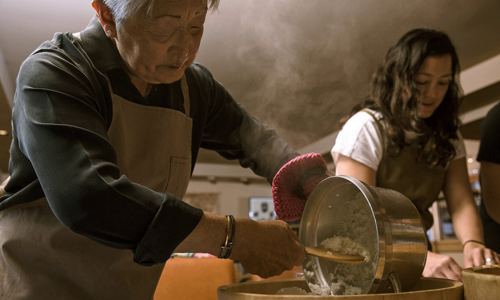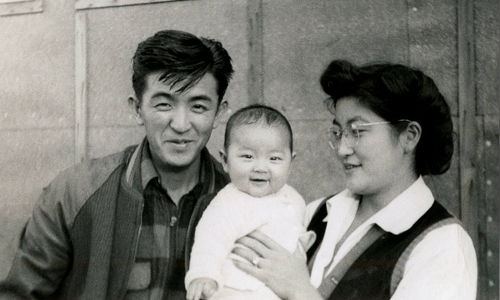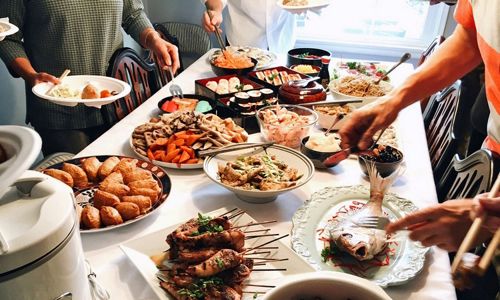Although living in the US, the Sasaki family has always kept the habit of preparing together a traditional Japanese New Year tray for over a century.
In the kitchen overlooking Mount Rainier and the Puget Sound Strait in Bainbridge Island, Washington State, 16 members of the Corinne Nakagawa Gooden family gathered to prepare for the New Year party.

Gooden (right) and her daughter prepare rice in a kitchen in Washington state Photo: NY Times
Gooden's two over-40-year-old daughters prepare inarizushi (tofu rolls) together: Amy brings freshly cooked rice to Sydne to sprinkle some sweet vinegar. Gooden's grandson helped cool the rice with her old paper fan. After that, everyone focused on stuffing rice in fried tofu bags with sugar and soy sauce. This is what they usually do on December 31 each year to prepare for the Oshogatsu, New Year festival of Japanese people.
Oshogatsu lasts for the first three days of the new year. Japanese families spend this time together, enjoying a traditional meal called osechi ryori. Osechi dishes, usually placed in large paint caskets, are prepared with soy sauce, sugar and sweet vinegar to preserve for three days of the New Year. Osechi caskets of the Kanto region, Kansai or Hokuriku often have sweet beans, salted vegetables, salted or steamed fish, dishes that symbolize luck and fortune in the new year.
Nowadays, Japanese women often rarely prepare this elaborate osechi tray due to their busy work. Instead, they usually buy it at supermarkets or department stores. Meanwhile, many young people in Japan prefer to travel at home with their families during Tet.
But the Gooden family has been keeping the habit of preparing osechi for many years, since their ancestors left Hiroshima, Japan, and settled in Seattle, USA, in the early 20th century.
When his grandfather, Shunroku Sasaki, arrived in Seattle in 1908, the Japanese neighborhood in this city was vibrant with many businesses serving young men who came to the US after Japan opened the border in 1868. They often worked in timber factories or fishing in the US West Coast in hopes of making a lot of money.
Like many young men at the time, Mr. Sasaki planned to return to Japan after having sufficient capital and fluency in English, the language of commerce and science. But after escaping death in a factory accident, he was persuaded by a close friend to stay and open a tailor shop for business people.
Mr. Sasaki only returned to Japan briefly to find a wife and had an arranged marriage with Hisaye Katayama, the daughter of a wealthy family in Hiroshima. Moving to Seattle, Sasaki worked as a manager for a small hotel.
Hisaye Sasaki was unable to do housework and cook osechi because she lived in the velvet from a young age. When she came to the United States, she was taught a traditional Japanese dish by a friend. In the Japanese neighborhood, she easily finds familiar ingredients and spices to cook osechi and often lets her daughters cook in the kitchen.

Gooden's parents and sister were at Minidoka camp, Idaho, in 1942 Photo: NY Times
Gooden's parents, Yemi Mary Catherine Sasaki and Noboru Nakagawa, married after US President Franklin D. Roosevelt issued an order of 9066 in February 1942. The decree came two months after the Japanese empire raided Pearl Harbor, prompting the US government to send Japanese people from Japan to concentration camps for fear of hostility.
"At that time, my mother was 6 months pregnant with my sister and they didn't know where to go," said Gooden. They were taken to a concentration camp the US government called the Harmony camp, about 56 km south of Seattle, and stayed there for six months. During this time, Yemi and her husband gave birth to their first daughter, Sherry, her sister Gooden. Later that year, the young couple was transferred to Minidoka camp in Idaho and stayed there for three years.
Mr. Nakagawa had to leave a grocery store in Seattle for a friend to look after with a dog named King. Mr. Nakagawa cried when he heard that King was dead, and that was the only time his family saw him in tears.
They celebrated the new year with sausages, pancakes and pasta in a dirty hall. They don't even have their own kitchen to prepare simple dishes like miso soup and rice.
The Nakagawa couple with their daughter, Sherry, were allowed to leave Minidoka in 1945 and returned to Seattle afterwards. Japanese Americans were often deprived of homes, farms, shops and restaurants. They are discriminated against, harassed and violated when looking for a home and a job. A year after the Nakagawa family left Minidoka, Mrs. Gooden was born.
In the house on Bainbridge Island, where Mrs. Gooden lived with her husband Bill LeMire, she kept her grandmother's items such as an iron kettle, ladles made of bamboo and wooden caskets used for tea ceremonies. Mother's embroidered silk paintings were also carefully hung on the wall.
Gooden and her sister Sherry, third generations of the Sasaki family in the US, were not taught Japanese or Japanese art. Ms. Gooden never returned to Japan until she was 70 years old. The family said they were not welcome there because they are now too American and unable to speak the language of their homeland.
But Gooden's two daughters, Amy and Sydne, are always curious about their origins. Both choose to study Japanese. Amy had been to Japan when she served in the navy. When Sydne worked in BondST restaurant in Manhattan, she also had the opportunity to return to Japan to learn sushi.

The traditional dishes that Mrs. Gooden's family prepared for Tet 2017 Photo: NY Times
Oshogatsu is the only Japanese holiday that the Sasaki family gathers together. In addition to typical osechi dishes, they prepare other traditional dishes such as sekihan (red bean sticky rice), maki-zushi (sushi wrapped with vegetables and eggs) and saba-zushi (vinegar saba fish).
After Mrs. Gooden's grandmother passed away and her mother suffered from dementia, the Sasaki family did not prepare osechi meals for several years of the 1990s. Ron Sasaki, Mrs. Gooden's cousin, was the one who initiated the idea. restore this traditional meal.
"Are you kidding? Do you know how these are made?" She told Ron Sasaki when he thought it was not difficult.
In Japan, it's the woman who is in charge of preparing the osechi, but in the Sasaki family, each person is in charge of a few dishes. The last evening of the year, they gathered together and cooked. They held a party with relatives and friends on January 1.
Ron Sasaki is in charge of grilled cod or cod, fried fish nanbanzuke and pickled herring. His father was a fisherman, so he often contributed salmon for the typical party of his homeland. Another cousin cooks Seattle-style teriyaki chicken with ginger and garlic. Gooden's sister lives in Hawaii so she often makes seaweed rice rolls and peanut butter mochi in this area.
This year is the first time that the Gooden family's fourth generation has participated in the preparation of osechi, with dishes such as tamagoyaki baked egg rolls, maki-zushi and sashimi (seafood salad).
They always start the party with a thick ozoni cake soup, including red and white Naruto fish cakes symbolizing the sun, the symbol of Japan.
Oshogatsu is a good time for the Sasaki family to get together, but the third and fourth generations of the family can openly talk about the things that their grandparents and parents were taken from in the United States, their country. love and call home. "Don't let the past happen again," Mrs. Gooden said.



 MariaLopez
MariaLopez







